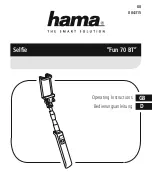
PAMS Technical Documentation
UI Module
NSB-7
Issue 1 06/00
ã
Nokia Mobile Phones Ltd.
Page 19
IR Module
An infrared transceiver module is designed to substitute an electrical cable between the
phone and a PC. The infrared transceiver module is a stand alone component capable to
perform infrared transmitting and receiving functions by transforming signals transmit-
ted in infrared light from and to electrical data pulses running in two wire asynchronous
databus. IR is located at the left bottom corner of the product.
The module is activated with an IRONX signal by the MAD, which supplies power to the
module. The IR datalines are connected to the MAD accessory interface AccIf via FBUS.
The AccIf in MAD performs pulse encoding and shaping for transmitted data and detec-
tion and decoding for received data pulses.
The data is transferred over the IR link using serial data at speeds 9.6, 19.2, 38.4, 57.6 or
115.2 kbits/s, which leads to maximum throughput of 92.160 kbits/s. The IR module used
does not comply with the IrDA 1.0 specification (InfraRed Data Association), which is
based on the HP SIR (Hewlett-Packard`s Serial InfraRed) concept. Maximum transmission
distance is set to 60cm.
In IR transmission a light pulse corresponds to 0-bit and a "dark pulse" corresponds to 1-
bit.
Figure 12: IR Transmission
The FBUS cannot be used for external accessory communication, when the infrared mode
Signal
Parameter
Min
Typ
Max
Unit
Notes
IRONX
IR-module on/off
0.7 x VBB
0
VBB
0.3 x VBB
V
lout@2mA, IR is at
off state
IR, is at on state
FBUS_RX
IR receive no pulse
IR receive pulse
0.7 x VBB
0
VBB
0.3 x VBB
V
FBUS_TX
IR transmit pulse
IR transmit no pulse
0.7 x VBB
0
VBB
0.3 x VBB
V
lout@2mA
UART TX
IR TX
startbit
stopbit
1
0
1
0
0
1
1
0
constant pulse
















































